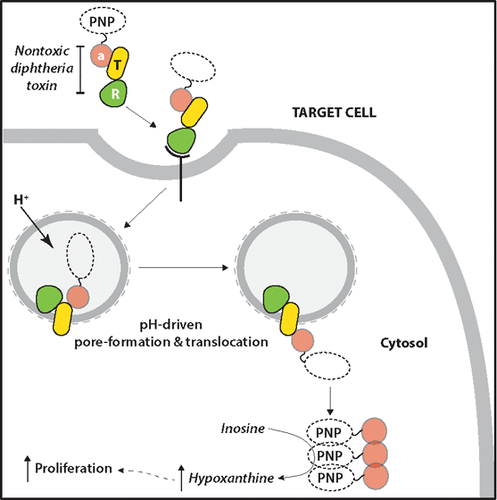当前位置:
X-MOL 学术
›
Mol. Pharmaceutics
›
论文详情
Our official English website, www.x-mol.net, welcomes your
feedback! (Note: you will need to create a separate account there.)
Intracellular Delivery of Human Purine Nucleoside Phosphorylase by Engineered Diphtheria Toxin Rescues Function in Target Cells
Molecular Pharmaceutics ( IF 4.5 ) Pub Date : 2018-09-13 00:00:00 , DOI: 10.1021/acs.molpharmaceut.8b00735 Minyoung Park , Xiaobai Xu , Weixian Min , Seiji N. Sugiman-Marangos , Greg L. Beilhartz , Jarret J. Adams 1 , Sachdev S. Sidhu 1 , Eyal Grunebaum 2 , Roman A. Melnyk
Molecular Pharmaceutics ( IF 4.5 ) Pub Date : 2018-09-13 00:00:00 , DOI: 10.1021/acs.molpharmaceut.8b00735 Minyoung Park , Xiaobai Xu , Weixian Min , Seiji N. Sugiman-Marangos , Greg L. Beilhartz , Jarret J. Adams 1 , Sachdev S. Sidhu 1 , Eyal Grunebaum 2 , Roman A. Melnyk
Affiliation

|
Despite a wealth of potential applications inside target cells, protein-based therapeutics are largely limited to extracellular targets due to the inability of proteins to readily cross biological membranes and enter the cytosol. Bacterial toxins, which deliver a cytotoxic enzyme into cells as part of their intoxication mechanism, hold great potential as platforms for delivering therapeutic protein cargo into cells. Diphtheria toxin (DT) has been shown to be capable of delivering an array of model proteins of varying sizes, structures, and stabilities into mammalian cells as amino-terminal fusions. Here, seeking to expand the utility of DT as a delivery vector, we asked whether an active human enzyme, purine nucleoside phosphorylase (PNP), could be delivered by DT into cells to rescue PNP deficiency. Using a series of biochemical and cellular readouts, we demonstrate that PNP is efficiently delivered into target cells in a receptor- and translocation-dependent manner. In patient-derived PNP-deficient lymphocytes and pluripotent stem cell-differentiated neurons, we show that human PNP is efficiently translocated into target cells by DT, where it is able to restore intracellular hypoxanthine levels. Further, through replacement of the native receptor-binding moiety of DT with single-chain variable fragments that were selected to bind mouse HBEGF, we show that PNP can be retargeted into mouse splenocytes from PNP-deficient mice, resulting in restoration of the proliferative capacity of T-cells. These findings highlight the versatility of the DT delivery platform and provide an attractive approach for the delivery of PNP as well as other cytosolic enzymes implicated in disease.
中文翻译:

人嘌呤核苷磷酸化酶通过工程性白喉毒素的胞内递送拯救了靶细胞的功能
尽管在靶细胞内部有大量潜在的应用,基于蛋白质的治疗方法由于蛋白质无法轻易穿过生物膜并进入细胞质溶胶而在很大程度上限于细胞外靶。细菌毒素将细胞毒性酶作为其中毒机制的一部分传递到细胞中,作为将治疗性蛋白货物传递到细胞中的平台具有巨大的潜力。白喉毒素(DT)已被证明能够将多种大小,结构和稳定性不同的模型蛋白作为氨基末端融合物传递到哺乳动物细胞中。在这里,为了扩大DT作为传递载体的用途,我们询问DT是否可以将活性的人类酶嘌呤核苷磷酸化酶(PNP)传递到细胞中以挽救PNP缺乏症。使用一系列的生化和细胞读数,我们证明PNP以受体和易位依赖的方式有效地传递到靶细胞中。在患者衍生的PNP缺陷型淋巴细胞和多能干细胞分化的神经元中,我们显示人NP被DT有效转移到靶细胞中,在那里它能够恢复细胞内次黄嘌呤的水平。此外,通过用选择与小鼠HBEGF结合的单链可变片段替换DT的天然受体结合部分,我们显示PNP可以从PNP缺陷型小鼠重新靶向进入小鼠脾细胞,从而恢复增殖能力T细胞。
更新日期:2018-09-13
中文翻译:

人嘌呤核苷磷酸化酶通过工程性白喉毒素的胞内递送拯救了靶细胞的功能
尽管在靶细胞内部有大量潜在的应用,基于蛋白质的治疗方法由于蛋白质无法轻易穿过生物膜并进入细胞质溶胶而在很大程度上限于细胞外靶。细菌毒素将细胞毒性酶作为其中毒机制的一部分传递到细胞中,作为将治疗性蛋白货物传递到细胞中的平台具有巨大的潜力。白喉毒素(DT)已被证明能够将多种大小,结构和稳定性不同的模型蛋白作为氨基末端融合物传递到哺乳动物细胞中。在这里,为了扩大DT作为传递载体的用途,我们询问DT是否可以将活性的人类酶嘌呤核苷磷酸化酶(PNP)传递到细胞中以挽救PNP缺乏症。使用一系列的生化和细胞读数,我们证明PNP以受体和易位依赖的方式有效地传递到靶细胞中。在患者衍生的PNP缺陷型淋巴细胞和多能干细胞分化的神经元中,我们显示人NP被DT有效转移到靶细胞中,在那里它能够恢复细胞内次黄嘌呤的水平。此外,通过用选择与小鼠HBEGF结合的单链可变片段替换DT的天然受体结合部分,我们显示PNP可以从PNP缺陷型小鼠重新靶向进入小鼠脾细胞,从而恢复增殖能力T细胞。











































 京公网安备 11010802027423号
京公网安备 11010802027423号